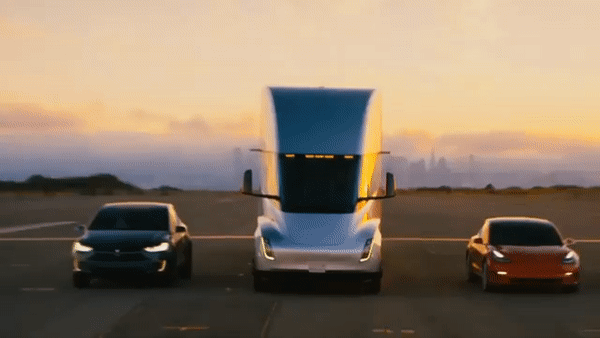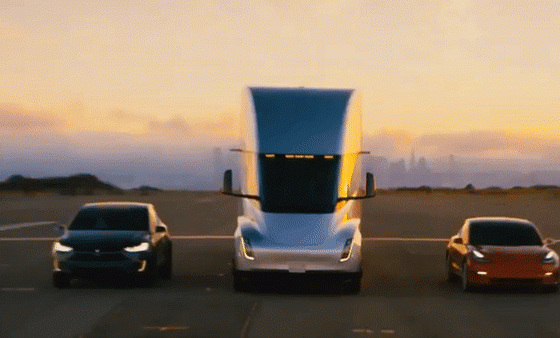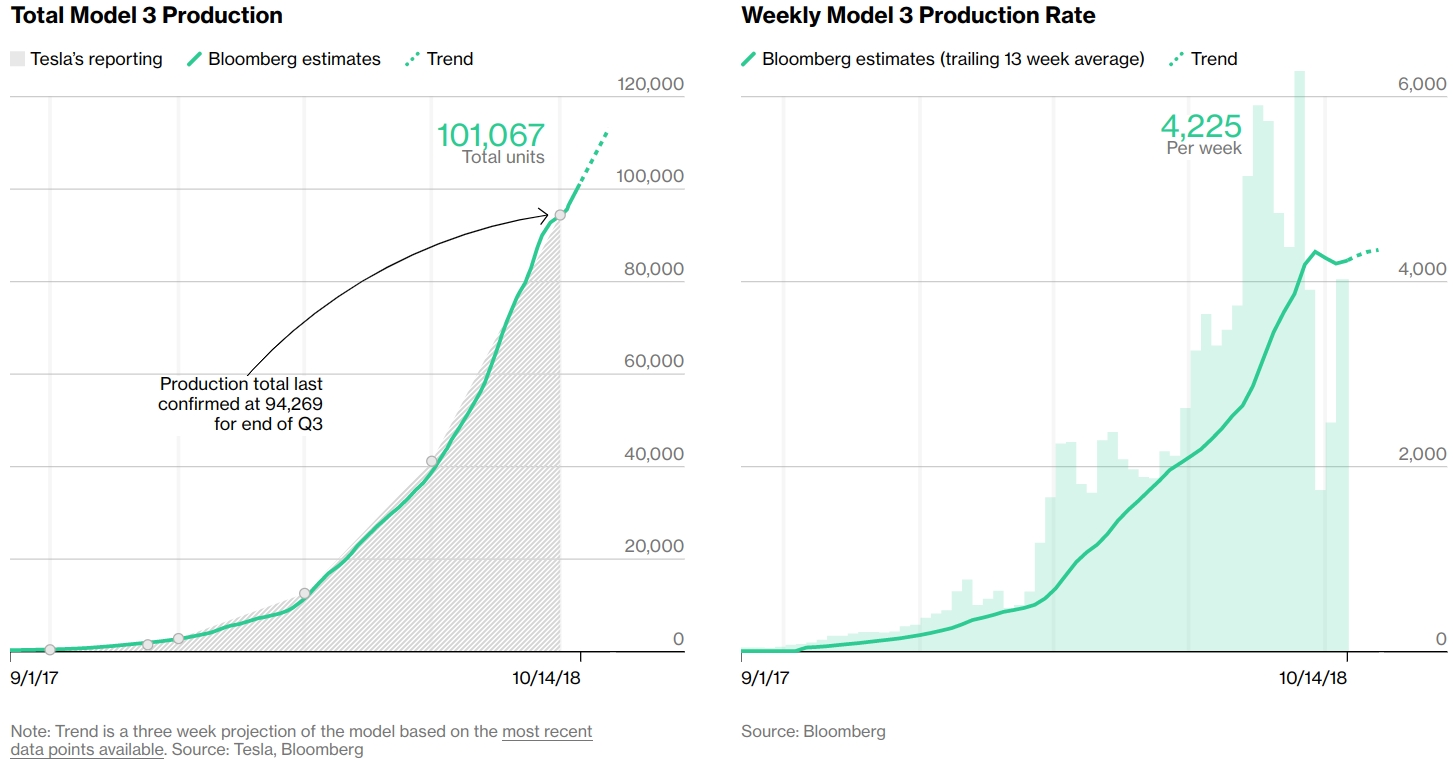

Investor's Corner
Tesla charges towards record Q4 with 13.7k new Model 3 VIN registrations in 2 days
Tesla ended the third quarter on a strong note, but if the electric car maker’s activities this October so far are any indication, it appears that the company is looking to end Q4 in an even more remarkable fashion. Amidst reports that Tesla has produced the 100,000th Model 3, the Silicon Valley-based company also registered more than 13,000 new Model 3 VINs in just two days.
This weekend’s VIN registrations were notable, considering that as of October 8, Tesla had already registered around 17,800 Model 3 in Q4. This past weekend’s filings were remarkable in their own right, as it saw the registration of the biggest batch of Model 3 VINs yet – 9,426 vehicles, ~52% of which are estimated to be Dual Motor AWD. With these latest filings, Tesla had registered a total of 148,386 Model 3 VINs to date.
#Tesla registered 9,426 new #Model3 VINs. ~52% estimated to be dual motor. Highest VIN is 148386. https://t.co/3pDIYHWgim
— Model 3 VINs (@Model3VINs) October 14, 2018
Tesla’s rate of VIN registrations appears to be picking up this month. October is only halfway through, but the company had already filed 30,478 new Model 3 VINs. If Tesla continues with this pace, October could easily be a record month for the Model 3’s registrations. While VIN registrations do not directly correspond to the number of vehicles immediately being produced by the carmaker, the rate of filings does give an idea about the pace of the Model 3 ramp. Elon Musk acknowledged this in the Q1 2018 earnings call, when he noted that “any information that we provide would be a week or two in advance of what will become public knowledge just due to vehicle registrations and shipments that are tracked very carefully.”
Earlier this week, Bloomberg‘s Tesla Model 3 production tracker, which has become more accurate with time, also showed that the overall production of the electric sedan has gone past the 100,000-mark. The tracker, which uses data from VIN registrations, social media reports from Model 3 owners, as well as direct reports submitted to the publication, currently estimates a total of 101,067 Model 3 built to date.
As further signs emerge of Tesla’s Model 3 ramp hitting its stride, it seems like Elon Musk’s long-term play for the electric car’s production is finally taking shape. When Musk envisioned the manufacturing of the Model 3, he saw an automated machine that builds the machine – one that would look nothing short of an “Alien Dreadnought.” The first 12 months following the start of the Model 3’s production proved challenging for Elon Musk and Tesla, though, as one bottleneck after another started emerging from both the Fremont factory and Gigafactory 1.

Eventually, it would be Tesla’s capacity to explore out-of-the-box strategies that ultimately made a difference in the Model 3 ramp. As Tesla adopted a more balanced workforce that utilized both humans and robots to construct the electric sedan, the company also looked into more unorthodox strategies to hit its targets. At the final month of Q2, for example, Tesla set up GA4, a Model 3 assembly line built inside a sprung structure. George Galliers, an analyst from Evercore ISI in London, visited the Fremont factory and noted that GA4, despite being built on the controversial “tent,” “looks to be permanent and in theory should be able to support much faster cycle times” following more optimizations.
In Q3, it was also revealed that Gigafactory 1 is receiving more upgrades in the form of new Grohmann machines, which would be installed by the end of the third quarter or the beginning of Q4. These new Grohmann machines, according to analysts from Worm Capital, will “help module production become three times faster, and three times cheaper.” Panasonic, which previously announced that it is looking to finish its upgrades to Gigafactory 1’s battery cell production lines, has revealed that it is expediting the installation of new cell production lines as well.
It remains to be seen if the record batches of Model 3 VIN registrations are the result of improvements in the battery module production lines in Gigafactory 1. That said, considering Tesla’s tendency to continuously improve and innovate as it goes, it appears that the Model 3 ramp would be stable and strong enough to allow the company to charge ahead towards the end of 2018.
https://www.instagram.com/p/BoSgB3rBVVL/?taken-by=teslamotors

Investor's Corner
Tesla stock closes at all-time high on heels of Robotaxi progress

Tesla stock (NASDAQ: TSLA) closed at an all-time high on Tuesday, jumping over 3 percent during the day and finishing at $489.88.
The price beats the previous record close, which was $479.86.
Shares have had a crazy year, dipping more than 40 percent from the start of the year. The stock then started to recover once again around late April, when its price started to climb back up from the low $200 level.
This week, Tesla started to climb toward its highest levels ever, as it was revealed on Sunday that the company was testing driverless Robotaxis in Austin. The spike in value pushed the company’s valuation to $1.63 trillion.
Tesla Robotaxi goes driverless as Musk confirms Safety Monitor removal testing
It is the seventh-most valuable company on the market currently, trailing Nvidia, Apple, Alphabet (Google), Microsoft, Amazon, and Meta.
Shares closed up $14.57 today, up over 3 percent.
The stock has gone through a lot this year, as previously mentioned. Shares tumbled in Q1 due to CEO Elon Musk’s involvement with the Department of Government Efficiency (DOGE), which pulled his attention away from his companies and left a major overhang on their valuations.
However, things started to rebound halfway through the year, and as the government started to phase out the $7,500 tax credit, demand spiked as consumers tried to take advantage of it.
Q3 deliveries were the highest in company history, and Tesla responded to the loss of the tax credit with the launch of the Model 3 and Model Y Standard.
Additionally, analysts have announced high expectations this week for the company on Wall Street as Robotaxi continues to be the focus. With autonomy within Tesla’s sights, things are moving in the direction of Robotaxi being a major catalyst for growth on the Street in the coming year.
Elon Musk
Tesla needs to come through on this one Robotaxi metric, analyst says
“We think the key focus from here will be how fast Tesla can scale driverless operations (including if Tesla’s approach to software/hardware allows it to scale significantly faster than competitors, as the company has argued), and on profitability.”

Tesla needs to come through on this one Robotaxi metric, Mark Delaney of Goldman Sachs says.
Tesla is in the process of rolling out its Robotaxi platform to areas outside of Austin and the California Bay Area. It has plans to launch in five additional cities, including Houston, Dallas, Miami, Las Vegas, and Phoenix.
However, the company’s expansion is not what the focus needs to be, according to Delaney. It’s the speed of deployment.
The analyst said:
“We think the key focus from here will be how fast Tesla can scale driverless operations (including if Tesla’s approach to software/hardware allows it to scale significantly faster than competitors, as the company has argued), and on profitability.”
Profitability will come as the Robotaxi fleet expands. Making that money will be dependent on when Tesla can initiate rides in more areas, giving more customers access to the program.
There are some additional things that the company needs to make happen ahead of the major Robotaxi expansion, one of those things is launching driverless rides in Austin, the first city in which it launched the program.
This week, Tesla started testing driverless Robotaxi rides in Austin, as two different Model Y units were spotted with no occupants, a huge step in the company’s plans for the ride-sharing platform.
Tesla Robotaxi goes driverless as Musk confirms Safety Monitor removal testing
CEO Elon Musk has been hoping to remove Safety Monitors from Robotaxis in Austin for several months, first mentioning the plan to have them out by the end of 2025 in September. He confirmed on Sunday that Tesla had officially removed vehicle occupants and started testing truly unsupervised rides.
Although Safety Monitors in Austin have been sitting in the passenger’s seat, they have still had the ability to override things in case of an emergency. After all, the ultimate goal was safety and avoiding any accidents or injuries.
Goldman Sachs reiterated its ‘Neutral’ rating and its $400 price target. Delaney said, “Tesla is making progress with its autonomous technology,” and recent developments make it evident that this is true.
Investor's Corner
Tesla gets bold Robotaxi prediction from Wall Street firm
Last week, Andrew Percoco took over Tesla analysis for Morgan Stanley from Adam Jonas, who covered the stock for years. Percoco seems to be less optimistic and bullish on Tesla shares, while still being fair and balanced in his analysis.

Tesla (NASDAQ: TSLA) received a bold Robotaxi prediction from Morgan Stanley, which anticipates a dramatic increase in the size of the company’s autonomous ride-hailing suite in the coming years.
Last week, Andrew Percoco took over Tesla analysis for Morgan Stanley from Adam Jonas, who covered the stock for years. Percoco seems to be less optimistic and bullish on Tesla shares, while still being fair and balanced in his analysis.
Percoco dug into the Robotaxi fleet and its expansion in the coming years in his latest note, released on Tuesday. The firm expects Tesla to increase the Robotaxi fleet size to 1,000 vehicles in 2026. However, that’s small-scale compared to what they expect from Tesla in a decade.
Tesla expands Robotaxi app access once again, this time on a global scale
By 2035, Morgan Stanley believes there will be one million Robotaxis on the road across multiple cities, a major jump and a considerable fleet size. We assume this means the fleet of vehicles Tesla will operate internally, and not including passenger-owned vehicles that could be added through software updates.
He also listed three specific catalysts that investors should pay attention to, as these will represent the company being on track to achieve its Robotaxi dreams:
- Opening Robotaxi to the public without a Safety Monitor. Timing is unclear, but it appears that Tesla is getting closer by the day.
- Improvement in safety metrics without the Safety Monitor. Tesla’s ability to improve its safety metrics as it scales miles driven without the Safety Monitor is imperative as it looks to scale in new states and cities in 2026.
- Cybercab start of production, targeted for April 2026. Tesla’s Cybercab is a purpose-built vehicle (no steering wheel or pedals, only two seats) that is expected to be produced through its state-of-the-art unboxed manufacturing process, offering further cost reductions and thus accelerating adoption over time.
Robotaxi stands to be one of Tesla’s most significant revenue contributors, especially as the company plans to continue expanding its ride-hailing service across the world in the coming years.
Its current deployment strategy is controlled and conservative to avoid any drastic and potentially program-ruining incidents.
So far, the program, which is active in Austin and the California Bay Area, has been widely successful.








